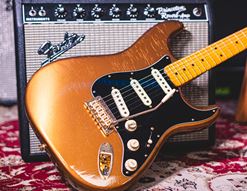What is a preamp? Do you need one? Today, we’ll straighten these questions out for you, and no doubt amaze you with the knowledge that you most likely already have a preamp! Let’s just crack on and explain this, shall we?
What is a Preamp?
What is a preamp? Okay, let’s explain this. We think it’s the term itself that may be confusing a few people. A preamp can exist in a number of different ways, but it’s always responsible for the same general job, and you’ve probably guessed plenty by its name: preamp simply means ‘pre-amplifier’ and is a stage in your signal - be that a guitar sound, a vocal performance or any other sound - that exists before that sound goes into an ‘amplifier’. We put that in quotes there because that amplifier can be a physical thing or a part of a digital plugin on your laptop.

You What?
Let’s simplify. Since we are guitarguitar, let’s take the example of a guitar note being played. This will give us one instance of a preamp in use, and then we’ll briefly look at where else you might find a preamp in your everyday musical life.
So, you plug your guitar into a combo amplifier and you play a note. Combo amps (i.e. not a ‘stack’, which is a head and separate speaker cabinet) are given that name because they are a combination of a preamp (there it is!), a power amp and a speaker. In this context, the preamp’s job is to take the electrical signal from your guitar (which is the note you just played after it has been transformed into electricity by the guitar’s pickup), turn that electrical sound into something we actually recognise as a guitar tone (gain, EQ etc. are all parts of the preamp) and then pass this sound on to the power amp section.

The power amp section is where the bigger valves and the transformer live, and this is the part that actually amplifies the signal, making it louder, basically. The speaker is of course the point where that loud signal is unleashed at your poor audience/neighbours.
So, What is a Preamp?
A preamp is simply that first part of the chain that your signal (guitar note, voice etc) meets before travelling on to the ‘make it louder’ part of an amp. It is responsible for ‘tone’ if you want to think of it in a simple, somewhat prosaic way. The preamp takes what is actually a pretty tiny signal and boosts it up to a level that is more useful for subsequent devices. You’ll understand this ‘boosting’ as input volume or gain, since it’s the same thing. It’s how distortion is ultimately achieved, as the input gain is overloading this section (you take it past ‘breaking up’ and lovely distortion happens), but turning that gain (volume) back to sensible levels is how you get warmth and harmonic richness into your sound.

So guitar and bass amps all have a ‘preamp’ section built into them and it’s the part that you interact with as a player. But, there are other types of preamp out there, too. Let’s take a look!
Studio Preamp
A studio preamp is a device for plugging microphones into in order to get a lovely, rich sound when recording vocals. Well, vocals and everything else really, but their primary attraction is in delivering vocal recordings with warmth and clarity. Some of these preamps exist inside larger mixing desks, some are standalone devices that are either rack mounted or of the desktop variety, and today, many exist as software plugins. Preamps can be included in audio interfaces (the boxes you plug everything into when you record stuff to your laptop) but lots of producers like using a separate preamp first, before the mic signal goes into the interface.
Studio preamps sometimes use valves to add warmth to the tone, much as valves are used in guitar amps. A top-end studio preamp can cost an eye-watering amount of money, but even top brands like Universal Audio also provide solutions that don’t cost the same as a car. If you are happy to work in the digital domain, you can buy preamps that are virtual models of famous old Neve desks and so on, in the same way that Helixes and Quad Cortexes model guitar amps and effects for us. This is a very cost-effective way of not only getting to grips with using a preamp but also trying out different varieties of preamp and developing preferences.

Acoustic Guitar Preamp
Another popular type of preamp is the type you’ll find in any electro-acoustic guitar. When we talk about an acoustic guitar having a ‘pickup’ installed, this is very much a fact, but a pickup on its own wouldn’t get the job done to any satisfactory degree. The signal strength of an acoustic guitar is pretty small, so something needs to be there to give it a boost, shape the tone a little (EQ out any whistley, howling frequencies) and send this louder, stronger, better signal out to the amp or PA system it’s plugged into.
That something would be, of course, a preamp! That’s what needs the battery, basically. An acoustic guitar pickup is actually a pickup and a preamp. There are many different ways in which this preamp manifests on an acoustic guitar - from chunky boxes with sliders on the guitar’s side to two discreet thumbwheels inside the soundhole - but they are all performing the same task. So, if you’ve ever used an acoustic guitar that ‘plugs in’, then you’ve already had some experience of using a preamp!

Some manufacturers like Fishman also offer floor-based preamp devices for running your guitar through, rather like an effects pedal, but with a focus on the preamp aspect. These can really transform your live sound, so are well worth investigating.
Do I Need a Preamp?
Do you need a preamp? Well, hopefully we’ve established by now that yeah, you probably do! Not only that, you probably already own at least one!
If you are recording regularly, it’s a good idea to at least try a preamp or two - whether physical or digital - to compare results with. We expect you’ll be impressed by how much of a professional edge you can gain by adding a preamp to whatever the mic is capturing.
If you are using any manner of amplification or digital modelling, then you will be interacting with preamps of certain descriptions quite often, as we’ve discussed today.

Amp-less guitarists often still use ‘amp-in-a-box’ units made by brands like Victory, so that they can run their entire sound from their pedalboards. These devices have a preamp as a major element. Preamps are everywhere!
Next time you are playing or recording, think about the preamp of whatever you may be using. It could be what’s giving you your great tone, or indeed it could be the part of your setup that needs replacing in order to take you to the Land of Great Tone!





















